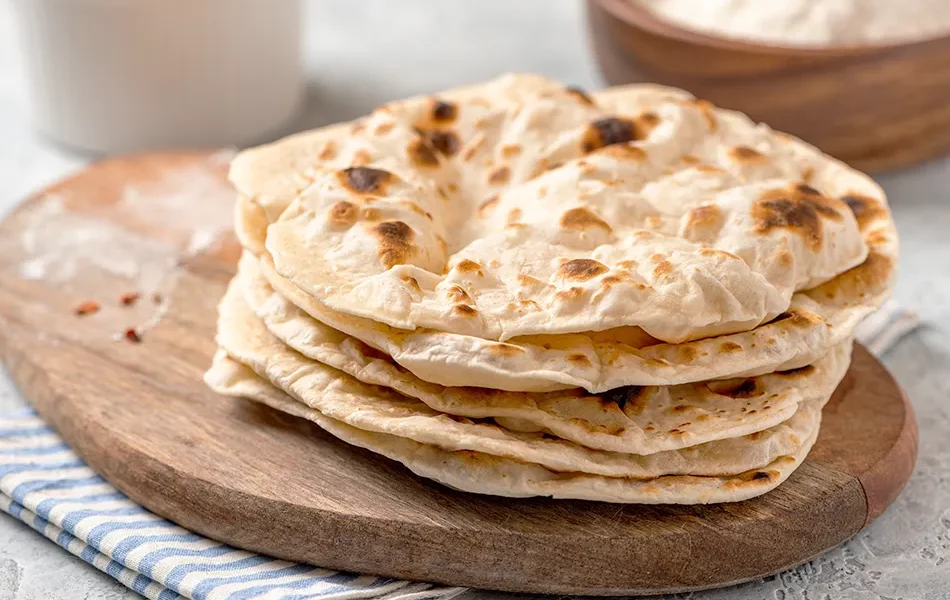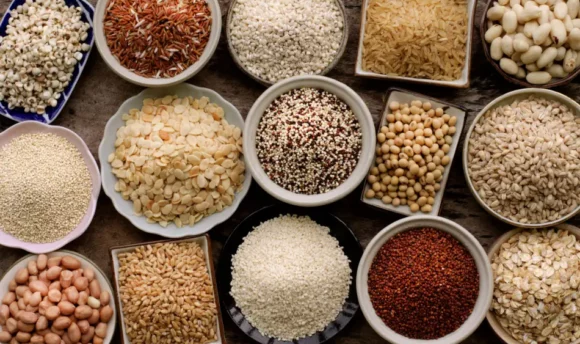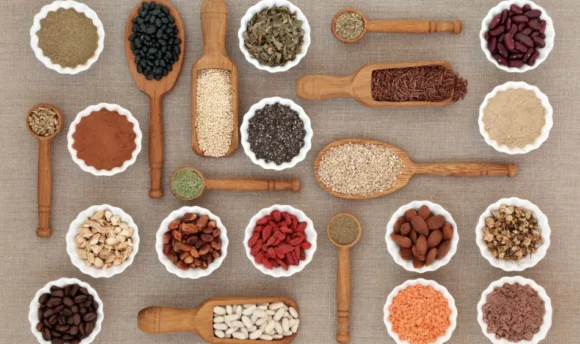Is Flatbread Healthy? Nutrition Facts and Health Benefits
Wondering if you can incorporate delicious flatbread recipes into your diet without sacrificing your health? Keep reading to find out.

Anyone who is trying to eat healthily or lose weight is probably nervous about eating bread.
Bread is a food that’s gotten a bad rap for its high carbohydrate content and alleged weight gain.
To make healthier choices, many people turn to flatbread, a thin and usually unleavened type of bread. But is it really the healthiest bread option? Below, we’ll take a deep dive into flatbread’s health benefits and potential downsides.
Is Flatbread Healthy?
No, not all flatbread can be considered healthy, especially if it’s made from unbleached white flour, which is commonly used in commercially baked bread. This is because this flour is highly refined and stripped of the vitamins and minerals commonly found in wheat germ.
If you want to eat flatbread while maintaining a healthy diet, try making it at home with flaxseed to increase its nutritional value, especially regarding fiber content.
Is Flatbread Healthier Than Regular Bread?
Whether or not flatbread is healthier than regular bread will depend on what is both in and on the bread. For example, homemade whole-wheat flatbread will always be healthier than commercially made white bread, which is high in sugar and full of preservatives.
3 Health Benefits of Flatbread
Trying to track down the healthiest bread option? Below, you’ll find a list of the potential health benefits of eating flatbread.
#1 Some flatbread can be low in calories
A 100-gram serving of flatbread options weighs in at approximately 250 calories, well below the daily recommendation of 2,000–2,500.
It depends on the flatbread. However, some are low in calories, such as cauliflower flatbread, naan, and whole-wheat tortillas.
#2 Reduces the risk of high cholesterol
Whole-grain bread and whole-wheat flatbread both include dietary fiber, which helps move LDL cholesterol through the digestive tract, limiting the amount absorbed into the bloodstream.
According to experts, the fiber in whole grains like flatbread lowers cholesterol and guards against heart attacks and strokes.
#3 Excellent source of energy
Flatbread made from whole grains is perfect because they will take longer to digest, giving you more energy for a longer time.
Try to avoid refined flour in your foods, including unbleached flour flatbread, because it can cause metabolic problems and spike your blood sugars, leading to diabetes and heart problems.
3 Downsides of Flatbread
Although whole-wheat flatbread can be considered a healthy alternative to white bread, there are certain health risks associated with flatbread consumption.
#1 Can cause a nutrient deficiency
Although delicious, flatbreads, especially those made with bleached white flour, don’t provide a lot of nutritional value. That’s why it’s important to eat flatbread as part of a balanced diet that includes fruits, vegetables, protein, and healthy fats.
#2 Potential weight gain
Carbohydrates are an important part of a well-balanced diet, but eating too many can lead to a calorie surplus, causing unwanted weight gain. Therefore, it’s important to moderate the consumption of foods like pita bread and follow a regular exercise routine.
#3 Bloating/digestion issues
Some of the most common digestive issues result from sensitivity or intolerance to grains, or more specifically, the protein in them – gluten. These digestive issues may cause abdominal pain and discomfort or constipation.
Nutrition Facts of Flatbread
From calories to carb content, let’s do a deep dive into the nutritional facts of flatbread.
Nutritional value (per 100g)
| Calories/Nutrient (per 100g) | Amount |
| Calories (kcal) | 249 |
| Net Carbs (g) | 35.8 |
| Fiber (g) | 1.8 |
| Sugar (g) | 1.75 |
| Fats (Total) | 7.89 |
| Protein (g) | 8.77 |
| Cholesterol (mg) | 0 |
Source: https://fdc.nal.usda.gov/fdc-app.html#/food-details/167945/nutrients
High in carbs
Flatbread is made up almost entirely of carbohydrates, with a 100-gram serving containing 35 grams of carbs, putting you well on your way to hitting the daily recommendation of 225–325 grams.
Moderate amount of proteins
With only 8.7 grams of protein in a 100-gram serving, it’s important that you include a healthy protein option like chicken or a protein shake with a whole-wheat pita flatbread to create a more well-rounded meal.
Moderate amount of sodium
Flatbread contains a moderate amount of sodium, with a 100-gram serving making up around 25% of the daily recommendation. For this reason, it’s important to practice portion control when enjoying this tasty bread.
Flatbread vs. Whole-Wheat Bread
| Product | Whole-wheat bread | Flatbread |
| Origin | Whole-wheat bread originated in Egypt, as it contained more vital nutrients than white bread. | Originated in Egypt and began as a specific Turkish flatbread known as markouk bread. |
| Description | Whole-grain bread contains wheat flour and often a variety of seeds, such as flaxseeds. | Flatbread is a type of bread that is flat, almost like pizza dough, and comes in many different variations. |
| Taste | Whole-wheat bread is pretty bland and nutty tasting, with a slightly bitter aftertaste. Less sweet than white bread. | Flatbread tastes similar to most other commercially baked bread, such as pita bread. |
| Calories (per 100g) | 252kcal | 249kcal |
| Net carbs (per 100g) | 43g | 35.8g |
| Fiber (per 100g) | 6g | 1.8g |
| Protein (per 100g) | 12g | 8.77g |
| Total fats (per 100g) | 3.5g | 7.89g |
| Sugar (per 100g) | 4.3g | 1.75g |
| Sodium (per 100g) | 455mg | 561mg |
| Cholesterol (per 100g) | 0mg | 0mg |
Homemade Flatbread Recipe
The healthiest bread is that which is made at home. The following recipe is something you can use to make a delicious pita bread healthier and more full of essential vitamins and minerals.
Ingredients
- ¼ cup roasted red peppers, chopped
- ¼ cup of olives
- 1 cup cherry tomatoes
- 4–5 cloves roasted garlic, minced
- 1 tsp lime juice
- 2 tsp fresh parsley
- 1 tbsp olive oil
- 1–2oz feta
- ½ ball of pre-made pizza dough
Directions
- In a bowl, mix the topping ingredients together until they are well combined.
- Preheat the oven to 450ºF/230ºC.
- Prepare to roll out pizza dough to the desired size.
- Oil the baking sheet and apply the dough and toppings.
- Bake for about 15 minutes or until crispy.
If you are eager for more ideas of healthy recipes you can make in the comfort of your own home, we would recommend checking out these amazing nutrition apps. They’re designed to help you incorporate more recipe variety into your diet.
FAQs
No, not all flatbread can be considered healthy, especially that which is made from bleached white flour. If you choose to eat flatbread, try and stick with whole-grain bread and homemade flatbread whenever possible to maximize its nutritional value.
Yes, most flatbreads are vegan, as they are primarily made of flour, salt, and water. However, naan bread is a type of flatbread typically not vegan as it often contains milk or yogurt.
No, flatbread is not generally gluten-free since it is made from wheat flour, though it is possible to find or make a flatbread using gluten-free flour.
A Word From Our Nutritionist
Bread is a food that many people have villainized, mostly due to its high carbohydrate content.
And though it’s important not to exceed the daily recommendation of having carbohydrates make up 45–65% of your caloric intake, it will definitely take more than a couple of pieces to get there.
When eating bread, your best options are those that are made with whole-wheat flour and loaves that are made at home. That being said, enjoying your favorite whole-grain sourdough or sprouted-grain bread is more than possible while following a healthy diet.
Conclusion
In conclusion, flatbread can have both positive and negative health effects. Still, one obvious approach is to know that whole-grain bread and whole-wheat pita flatbread are better choices than traditional pita bread.
Making healthy decisions can be simple if you choose healthier flour options and pay attention to the quantity and quality of your nutritional intake.

















































 Select your language:
Select your language: 








